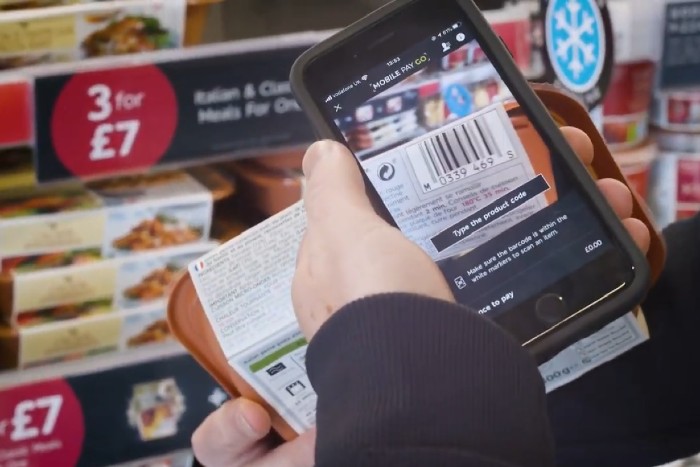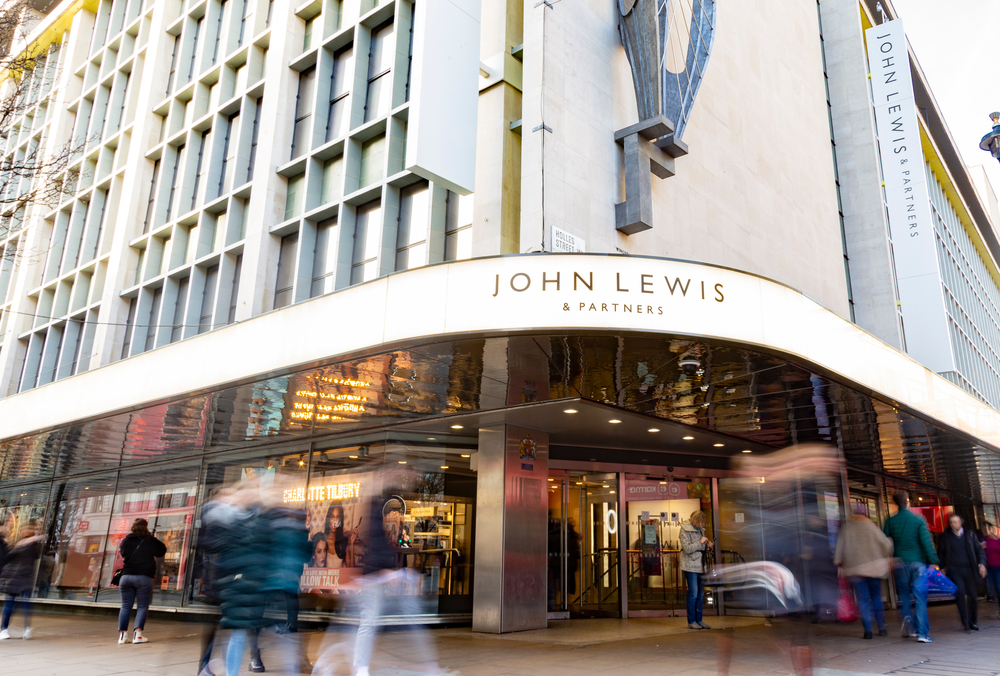Soon after the Covid-19 pandemic began, purchasing behaviours changed. As online shopping was already on the rise, the crisis accelerated ecommerce purchases, and led to customers spending less overall time in stores – particularly as restrictions came into force.
As all four countries in the UK remain under lockdown – meaning non-essential retailers must keep their stores shut – the high streets continue to witness low shopper numbers.
To benefit from the shoppers who still decide to visit stores as they’re classed as “essential”, Marks & Spencer launched an on-the-spot digital payment solution in December – Pay With Me – to speed up the shopping process for customers.

With many retailers now operating at maximum capacity and carefully counting customers, M&S’s Pay With Me app is aimed at helping free up space for more customers to enter the store and start shopping.
The solution allows an M&S staff member to pick out customers waiting in line to pay for just a few items, and quickly process their transaction via a handheld device.
Pay With Me was launched to help M&S benefit during the Christmas period, but still remains at 200 of its stores. It was initially trialled at seven stores: Kew, Epsom, Harrogate, White City, Cribbs Causeway, Biggleswade and Kinnaird Edinburgh.

M&S retail digital solutions programme manager Katherine Ash said digital payments were increasingly popular with customers – which is why it has offered a range of payment methods that “make shopping as easy and efficient as possible”.
“We know From Pay With Me to Mobile Pay Go, Scan & Shop to Apple Pay, we’ll continue to roll out new digital solutions to improve the shopping experience and power our digital transformation,” she told Retail Gazette.
“We launched Pay With Me at 200 of our busiest stores in the run up to Christmas to help bust the queues and make shopping quicker, easier and safer for everyone – and having served thousands of customers during the Christmas peak, the tech has been a real success, with some fantastic feedback from customers.
“Many customers said they enjoyed being pulled out of the queue and allowed a speedier exit – which we knew would be particularly important over Christmas, with our stores enforcing a maximum capacity and managing queues at the front door if necessary.”

M&S is not the first to implement this type of payment solution as digital payments had been popularising before the crisis.
In order to cut down the time spent in stores, Sainsbury’s introduced a virtual queuing system across its UK stores in July last year. Shoppers can join a virtual queue after downloading the Sainsbury’s app then monitor their position from any destination, before receiving a notification that they can enter the store.
Waitrose rolled out drive-through online grocery order collection services in August across its store estate allowing shoppers to collect items without entering the store. Customers can park in a dedicated parking spot and can collect or return items, including John Lewis goods, from the comfort of their vehicles.
The upmarket grocer then extended its bookable shopping slots service in December to more than 110 stores, following a successful trial during summer.
The various digital payment methods have landed at a time when shoppers have shown heightened expectations for frictionless shopping experiences due to the pandemic.
Social distancing facilitated the surge in ecommerce, increasing demand for digital payment methods over traditional cash payments. With contactless payments offering convenience, consumers are leaning towards it as they consider spending less time in stores.
In fact, research by Statista has shown that UK contactless payments strongly increased since April 2020.
Although the number had decreased between December 2019 and April 2020 – the first time in which such a downward trajectory has been seen – the total number of transactions via contactless cards went from 209 million to 519 million from April 2020 to June 2020.

While it appears that customers are shifting away from their dependence on staff in the wake of the pandemic, M&S’s Pay With Me requires staff assistance – which is arguably an unconventional move by M&S given the general move towards self service.
“Exploring new ways of enabling customers to make payments is one way in which that retailers can improve the quality of the customer experience,” said Nick Maynard, lead analyst at market research firm Juniper Research.
Ash argued that M&S also offered other digital payment solutions such as Scan & Shop, which allows customers to scan as they shop and pay for their items much quicker; and Mobile Pay Go, which allows customers to skip the queues and pay for their items using their smartphone.
In response to Covid-19, M&S also installed 1000 brand-new self-service tills at 69 of its high footfall stores, and offered its longest-ever opening hours at over 400 stores to help give customers more time to shop during Christmas.
Maynard said Pay With Me reflected a general shift away from fixed checkout infrastructure.
“Staff with portable terminals is already popular in specialist retail such as footwear,” he said.
“Self service via mobile app is also a great way to facilitate payments, but needs the correct marketing to advertise functionality to customers.”
He added that on-the-spot payments were convenient for users and eliminate the problem of going in to the shop for one item and waiting behind customers with full trolleys.

“Convenience to a user can mean how they are used to paying (e.g. at a fixed checkout) but it can also mean new models which are easier, such as on-the-spot,” Maynard said.
“However, there are potential drawbacks. New payment systems can also add confusion for the user, traditional experiences may be simpler for customers.
“On-the-spot payments may also distract from the mobile app checkout solutions that many retailers have been pursuing.”
Another drawback includes the lack of inclusion, in that solutions such as Pay With Me may only work for consumers purchasing a small number of items. It may appear unjust to consumers who are purchasing more but not being served as quickly as those purchasing less.
Retailers may need to utilise on-the-spot payments in combination with a broader omni-channel offering, which may include traditional checkouts, self-checkouts, scan-and-go, and click-and-collect. This way, retailers can ensure that customers can interact via their channel of choice be it physical or digital.
David Ringer, managing director at loyalty card app Stocard, said it was now vital for retailers to explore all methods of alternative payments available to them.
“Covid-19 has increased positive perceptions about contactless payments due to the safety, convenience and peace of mind they provide,” he said.
“On-the-spot payments solve the problem of going to shops for one item and waiting behind people with full trolleys”
Ringer argued that M&S has historically been slower than others to digitise point-of-sale or home deliveries, but it was now “making up ground and investing in technology designed to enhance the shopper experience, drive engagement and loyalty”.
“As consumer buying behaviour continues to shift, retailers that are investing in these digital solutions now stand to benefit the most in the long term,” he added.
Meanwhile, Nick Corrigan, managing director of Global Payments, said retailers needed to consider their driving force in seeking new technologies. For example, are they looking to gain efficiencies and speed up the payment process? Or enhance customer experience by eliminating queues?
“It is less about replacing traditional payments methods and more about finding innovative tech that complements them, expanding options and therefore the customer experience,” he told Retail Gazette.
“This is exemplified by M&S’s introduction of on-the-spot payments, which shortens queues and speed up the checkout time – the cashier is not a major part of the customer experience in this scenario and can be bypassed.
“The real challenge is integrating it into the overall customer experience and ensuring it is actually benefitting them.”
Retailers may need to explore ways to make shopping in a physical store quicker and safer considering how the Covid-19 pandemic continues to impact the retail experience. Most have already implemented changes such as social distancing measures and protective screens. On-the-spot payments facilitate faster, more efficient and safer shopping experiences for both retail staff and consumers.
On-the-spot payments is not exactly a ground-breaking trend, but it’s definitely convenient. As people crave safe and fast ways to complete their shopping without queues and friction points, the retailers that have adopted such methods are the ones likely to advance in a post-Covid world. Moreover, the new consumer habits that are taking root will become preferences that persist long after the pandemic.
Click here to sign up to Retail Gazette‘s free daily email newsletter


















